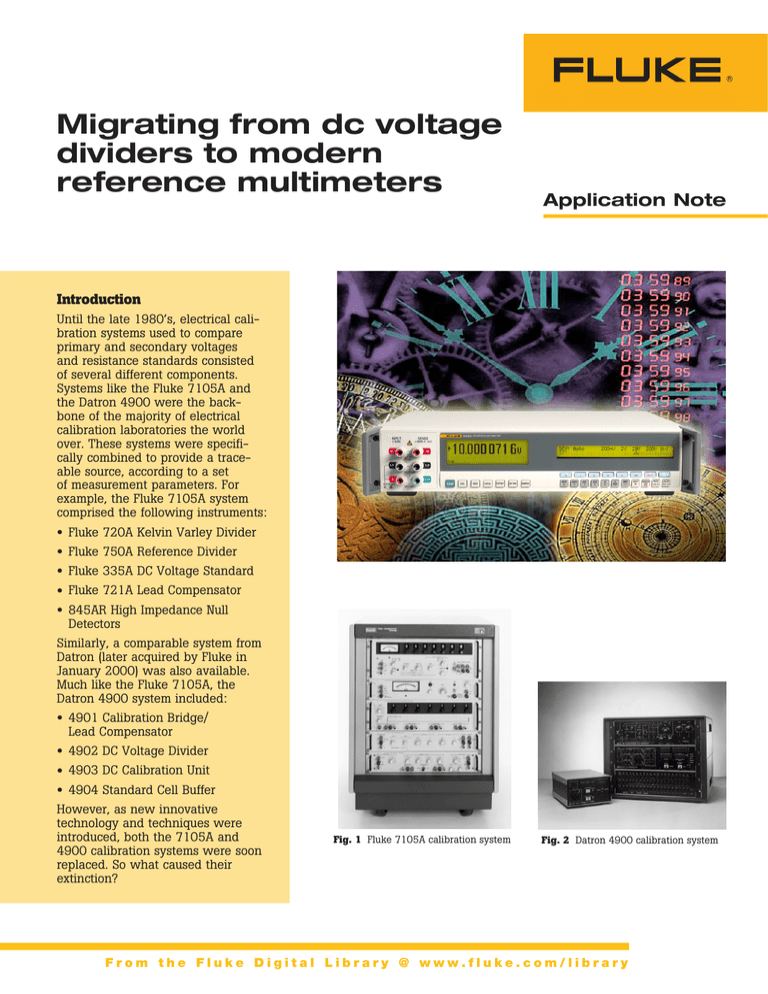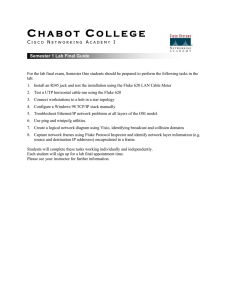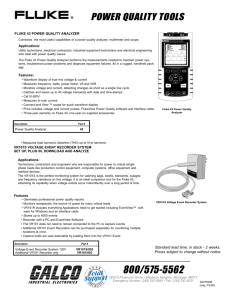
Migrating from dc voltage
dividers to modern
reference multimeters
Application Note
Introduction
Until the late 1980’s, electrical calibration systems used to compare
primary and secondary voltages
and resistance standards consisted
of several different components.
Systems like the Fluke 7105A and
the Datron 4900 were the backbone of the majority of electrical
calibration laboratories the world
over. These systems were specifically combined to provide a traceable source, according to a set
of measurement parameters. For
example, the Fluke 7105A system
comprised the following instruments:
• Fluke 720A Kelvin Varley Divider
• Fluke 750A Reference Divider
• Fluke 335A DC Voltage Standard
• Fluke 721A Lead Compensator
• 845AR High Impedance Null
Detectors
Similarly, a comparable system from
Datron (later acquired by Fluke in
January 2000) was also available.
Much like the Fluke 7105A, the
Datron 4900 system included:
• 4901 Calibration Bridge/
Lead Compensator
• 4902 DC Voltage Divider
• 4903 DC Calibration Unit
• 4904 Standard Cell Buffer
However, as new innovative
technology and techniques were
introduced, both the 7105A and
4900 calibration systems were soon
replaced. So what caused their
extinction?
Fig. 1 Fluke 7105A calibration system
Fig. 2 Datron 4900 calibration system
From the Fluke Digital Library @ www.fluke.com/library
Evolution caused these
more mature calibration
systems to begin the road
to obsolescence
More recently, the introduction of the Fluke 8508A Reference Multimeter has taken all
of these philosophies a step
further to improve accuracy,
There have been several
linearity and stability, and
contributing factors to the
has combined them into a
demise of the old 7105A and
functionally versatile, easy-to4900 calibration systems. First,
use solution. This has enabled
the development of artifact
metrologists to perform highly
calibration has not only
accurate and automated
consolidated the system into a
measurement tasks within a
single device, but has also fully single instrument, replacing the
automated the process.
need for Kelvin-Varley dividSecond, the design of modern ers, null detectors, resistance
calibrators incorporates pulse
bridges and even PRT (Platinum
width modulation (PWM)
Resistance Thermometer)
techniques to maintain a ‘right
calibrators. This ultimately
by design philosophy’ that
means faster calibrations,
provides extremely repeatable
reduced support costs, greater
source linearity. Furthermore,
throughput and minimal manual
zener reference technology
operations.
improved, and, when
incorporated within calibration equipment, subsequently
improved stability reducing
uncertainties. Finally, high
resolution DMMs like the
Wavetek 1281 then managed
to combine these features into
a highly accurate electrical
measurement instrument.
Fig. 3 Two stage PWM circuit
Fluke Corporation
Migrating from dc voltage dividers to modern reference multimeters
Calibrators evolve with
pulse width modulation
(PWM)
Pulse width modulation topology can be found in a variety of
applications, including various
telecommunications applications, power generation and
signal processing. Because of its
exceptional linearity benefits,
most calibrators today now
include this technique in their
own internal ratio divider. Such
a circuit is typically made up
from a two stage switching FET
design with synchronous control
clock. This circuit passes the dc
reference voltage through the
switching FET array and then
filters their summed outputs to
provide an average output voltage that is determined by the
resulting waveform’s duty cycle.
(see figures 3 and 4).
The output is then passed
through a multi-stage, low
pass filter network, capable of
eliminating all ripple and noise
content, and thus providing a
highly stable and linear output
voltage. The output voltage can
be expressed using the formula:
VO = VIN × X/n
The ratio divider criterion in a
calibrator is consequently set
by the frequency of the control
clock driving the two FETs.
As with any ratio divider,
the PWM technique operates
on the basis of ‘dimensionless’ ratio. That is, there are no
absolute quantities involved
that are subject to change over
time offering very repeatable
linearity dependent only upon
an extremely reliable digital
clocking waveform. To further
maintain high confidence,
linearity is subsequently verified
during artifact calibration. This
approach compares the same
two fixed voltages, V1 and V2,
on different ranges. Figure 5
illustrates this comparison. If the
PWM is perfectly linear, then
N4/N3 = N2/N1.
Fig. 4 A representation of the output voltage prior to filtering
The development of
artifact calibration
Artifact calibration is a
process where calibrators
automatically perform internal
ratiometric comparisons and
store the correction data relative to a few precise external
artifact standards.
Fig. 5 Converter linearity verification
Fluke Corporation
Migrating from dc voltage dividers to modern reference multimeters
Traditionally these comparisons were performed using an
assortment of ratio measuring equipment to achieve this.
However, over the last twenty
years, instruments with artifact
calibration capability have all
but eliminated many of these
labor-intensive measurement
tasks. Many traditional manual
operations to establish voltage,
resistance or current ratios can
now be accomplished automatically within the instrument,
consequently providing consistent and efficient calibrations,
as well as significantly reducing
the costs previously associated
with higher labor intensity and
a larger equipment inventory.
Fundamentally, an instrument with artifact calibration
capabilities will first transfer
and then reference to a set of
external artifact voltage and
resistance standards. Having
been transferred, this internal
voltage reference can then be
configured to appear as if it
had been applied to an internal
array of comparable instruments
like a Kelvin-Varley divider, a
null detector or even a decade
divider, though in practice this
is not really the case.
Technology advances have
shrunk the null detector onto
a miniature hybrid integrated
circuit, the ratio system is now
a single PWM printed circuit
board, and improved lower
cost thin film resistor networks
have replaced bulky wirewound resistor ratios. This
kind of advance in technology
now means that designers can
produce highly comprehensive instruments with artifact
calibration capability. So now,
having eliminated these extra
external devices and mimicked
the same capability from within
the instrument, we can now
transfer the accuracy of the
artifact to the various ranges
of the instrument with minimal uncertainty, with greater
accuracy and stability, and with
complete traceability.
The dawning of the high
resolution DMMs
As discussed earlier, artifact
calibration is a particularly
efficient and easy method of
carrying out a multitude of calibrations. However, while being
an acceptable method of calibration, it does come at a price.
Therefore, artifact technology
is normally found on calibrators at the premium end of the
range. While lower performance, less accurate calibrators
forego artifact design, adopting
more traditional direct function-to-function, range-to-range
verification.
Even with artifact calibration,
it has been generally recommended by all manufacturers
to fully verify each range using
external methods at least twice
in its first year, and then subsequently every two years. It is
this reason that many laboratories would, and in some
cases still do, resort to more
traditional calibration systems,
like the Fluke 7105A or Datron
4900, to accomplish this.
Fig. 6 An example of a Fluke 7105A or datron 4900 voltage calibration system
Fluke Corporation
Migrating from dc voltage dividers to modern reference multimeters
Today, most laboratories
with a large installed base of
calibrators carry out the process
of their verifications using high
resolution digital multimeters
like the Fluke 8508A Reference multimeter. These meters
can be used to perform all of
the functions previously associated with the older calibration systems with little or no
degradation of uncertainties.
Another real benefit with using
these meters comes from the
considerable reduction with
inter-connection leads and
the immense time saved to reconfigure the setup for a different measurement. Add to this
the ability to fully automate the
calibration process, and the
reference multimeter becomes
very easy to justify over most of
the traditional systems.
Calibrating the calibrator
before the days of longscale DMMs
to the temperature coefficient
of the ratio resistors, meant
that this process would have
required a skilled metrologist
The advantages of using a
who knew how to perform this
single high resolution DMM over operation both competently and
the traditional multi-instrument promptly. Having calibrated the
calibration systems are probdivider, the UUT calibrator could
ably best demonstrated by
now be connected as described
firstly describing how a typical
in figure 6. With a null deteccalibration would have been
tor between the ratio divider
carried out. Figure 6 illustrates
and 10 V dc reference, the
the source calibrator (UUT), an
source calibrator would now be
external divider, null detector
adjusted until the null detector
and a 10 V dc reference in a
indicator displayed zero. (Any
conventional voltage calibration residual error would contribute
setup.
to the expanded uncertainty.)
Here the 100 V dc source
From this brief description,
(UUT) is being verified against
you can probably begin to
a 10 V reference, using a ratio
comprehend how complex this
divider of 10:1. In reality the
particular measurement process
ratio divider would have several is. In addition, the lack of any
‘taps’ calibrated to a set of
kind of remote capability, the
definitive ratios i.e. 100:1, 10:1, time consuming makeup of the
1:1 V and 0.1:1 V. Before any
procedure and, above all, the
verification of voltage could
overall cost of the system, only
take place, the individual ratios serves to further compound the
would have first been calibrated situation. Nonetheless, advances
separately so that the given
in technology, coupled with the
ratios exactly represented the
need to make the methodolsource instrument’s output volt- ogy simpler, faster, cheaper and
age at each voltage step. The
more efficient, help set a new
possibility of drift with time, due precedent within the industry.
Fig. 7 An example of the reference multimeter being used to accurately verify the
output of the artifact calibrator to a known voltage reference
Fluke Corporation
Migrating from dc voltage dividers to modern reference multimeters
Early precision high resolution
DMMs like the Fluke 8505/8506
consolidated the methods used
by all of the test devices illustrated in figure 6 into a single
instrument, so eliminating most
interconnecting lead errors,
greatly reducing the overall cost
of the calibration system, but
moreover, allowing full automation of virtually all measurement
tasks. This in turn liberated the
senior metrologist from this task
and allowed him/her to concentrate on other important laboratory responsibilities.
Reference multimeter
with reference standard
accuracy and stability
High resolution precision DMMs
have been available for almost
thirteen years, but since their
launch in the late 1980s the
products have remained comparable in both performance
and application. Since Fluke’s
acquisition of precision instrument manufacturer WavetekDatron in 2000, design teams
in the US and UK have worked
together and pooled their
expertise to produce the best in
precision and long-scale DMM
design—the Fluke 8508A Reference Multimeter. The 8508A
has taken many of the leading Fluke and Wavetek-Datron
patented multimeter designs
and then improved them
further, using the latest state
of the art technology and new
electronic measurement design
techniques.
For the example given in
Figure 6, the Fluke 8508A
eliminates every instrument
other than the 10 V reference.
In essence, the function of both
the ratio divider network and
null detector has now been
replicated into the 8508A.
Furthermore, all interconnecting leads that existed
between these two instruments
have also been eradicated,
removing the probability of lead
errors and consequently the
need to compensate for these
errors. Having connected the
10 V reference to the Fluke
8508A’s second input channel (rear input), the 100 V dc
from the UUT being standardized can then be applied to the
8508A’s front input channel.
This is typically done as shown
in figure 7. The 8508A Reference Multimeter has two input
channels that can be automatically switched to perform a ratio
measurement. The 10 V reference would be connected to the
8508A’s rear input (channel B),
with the UUT’s 100 V dc voltage connected to the 8508A’s
front input (channel A). In Ratio
mode, the 8508A displays the
ratio of the inputs in the form
F-R (front minus rear), or F/R
(front as a ratio of the rear),
or (F-R)/R (the difference as a
ratio of the rear). In the example
given, the F/R (i.e. the front as
a ratio of the rear) mode would
be used. In this mode, with the
10 V dc reference connected
to the rear channel and 100 V
connected to the front channel, the display would show
+10.000 000 . This is the ratio
of the unknown 100 V to the
known 10 V reference. Note
that the reference multimeter
is measuring the whole voltage for each channel and is
configured to a single dc voltage
range (200 V). Consequently,
the only significant error contributions to this measurement
are the uncertainty of the 10 V
Fluke Corporation
reference standard, the noise
and differential linearity of the
reference multimeter and the
noise of the 100 V UUT. Typical
noise of the reference multimeter is less than 50 nV pk/pk
(7½ Normal and 8½ Fast ADC
modes) with the differential
linearity in 8½ digit mode being
better than 0.1 ppm of range
over a value ranging from 10 V
to 1 V (halve the typical linearity spec for values spanning
the entire DMM scale from 0 to
19.99999 V).
Note: the above procedure assumes that the
10 V dc reference standard being used is
calibrated and has an assigned value. The
assigned value is keyed into the 8508A math
memory subsequently correcting any residual
gain error on the multimeters 200 V range.
Typical procedure sequence:
1)Select DCV 200 V range
2)Connect low thermal cables
to the 8508A front and rear
terminals (8508A-LEAD).
3)Short the Front A and Rear
B inputs at the cable ends of
the 8508A and perform zero
range function.
4)Remove shorts and connect
calibrator to 8508A front input.
5)Connect 10 V reference
standard (e.g. Fluke 7001) to
8508A rear input.
6)Select math mode, enter the
assigned reference standard
value into the 8508A “m”
variable.
7)Select scan, F/R and allow
two minutes for stabilization.
8)Select Math *m.
9) The 8508A will now perform
the ratio reading, multiply it
by the traceable reference
standard value and display
the UUT normalized value on
the front display.
Migrating from dc voltage dividers to modern reference multimeters
The uncertainty associated with
this measurement is similar to
that which might be obtained
by a skilled metrologist with a
newly calibrated voltage divider
and a null detector. In addition, the reference multimeter
can make this measurement for
prolonged periods, as its linearity does not change significantly
over time.
Uncertainty components.
1)DMM short term stability
when measuring 100 V.
2)DMM short term stability
when measuring 10 V.
3) DMM linearity.
The 8508A specifications detail
the uncertainty for the DMM
as: 10 V measured on the 200
V range to eliminate range
switching using 20 minute
transfer specification = 0.4 ppm
of Reading + 0.1 ppm of range
RSS above result with 100 V
measured on the 200 V range
using similar transfer specification and the total measurement
uncertainty is approximately
2.5 ppm of Ratio.
The 0.4 ppm of reading
accounts for noise and 0.1
ppm of range accounts for a
conservative linearity specification. Therefore, as two individual measurements are being
performed during ratio mode,
the transfer specification for
each measurement is RSS’d
together to yield a measurement
uncertainty of 2.5 ppm of Ratio
reading. Some additional uncertainty may be considered for
the source.
Fig. 8 A typical example of type testing linearity on the Fluke 8508A
A conservative linearity specification is assigned to multimeters during development as part
of type testing. The specification
supports a worst case linearity
measurement which is often at
the two extremes of a range. In
practice this spec is often very
conservative, an example would
be to compare a known (traceable) 10 V with unknown 10 V
standard on a fixed range—what
is the linearity spec? In this
example there is negligible
contribution to linearity as each
measurement is being made
at the same point in a given
range. Linearity measurements
could be performed on every
multimeter to yield better specs.
However, who should determine how many points are
measured to gain confidence?
Fluke Corporation
This exercise is time consuming and requires extremely low
measurement uncertainty often
only achievable using JJ Array
standards. Figure 8 shows an
example of type testing linearity
on the 8508A multimeter. The
graph indicates deviation from
ideal in ppm of range at various points on the multimeters
+20 V range. A published spec
of 0.2 ppm of range is assigned,
yet type testing results in better
than ± 0.035 ppm of range as
indicated by the two extremes
of deviation from the ideal
linearity.
Summary
In summary, a comparison
of measurement uncertainty
between divider system and
8508A will often favor the
traditional divider systems.
However the improvements in
measurement uncertainty will
be at a cost!
Migrating from dc voltage dividers to modern reference multimeters
Uncertainty may be compromised using modern instrumentation, but further consideration
must be given to the intended
application and how it may
have changed. Precision calibrators once required divider
type measurement uncertainty
now implement artifact calibration. Where linearity verification
is involved, divider technology
is now internal to the calibrator design. This is not true of
all calibrators where linearity
measurement using multimeter
performance remains adequate
for lower priced, less accurate
calibrators.
Other precision instruments in the range
5720A Multifunction Calibrator
525A Temperature/Pressure Calibrator
The lowest uncertainties of any
multifunction calibrator
Superior accuracy and functionality
in an economical benchtop package
9500B Oscilloscope Calibrator
8845A/8846A Precision Digital Multimeters
High accuracy calibration of analog
and digital-storage oscilloscopes up
to 3.2 and 6 GHz
Precision and versatility for bench
or systems applications
Fluke 8508A Reference Multimeter
Reference standard accuracy and stability, in one functionally versatile,
easy to use solution.
Fluke.Keeping your world
up and running.™
Fluke Corporation
PO Box 9090, Everett, WA USA 98206
Fluke Europe B.V.
PO Box 1186, 5602 BD
Eindhoven, The Netherlands
For more information call:
In the U.S.A. (800) 443-5853 or
Fax (425) 446-5116
In Europe/M-East/Africa +31 (0) 40 2675 200 or
Fax +31 (0) 40 2675 222
In Canada (800)-36-FLUKE or
Fax (905) 890-6866
From other countries +1 (425) 446-5500 or
Fax +1 (425) 446-5116
Web access: http://www.fluke.com
©2006 Fluke Corporation. All rights reserved.
Printed in U.S.A. 9/2006 2114953 A-EN-N Rev B
Fluke Corporation
Migrating from dc voltage dividers to modern reference multimeters





